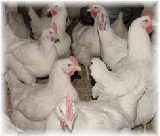| |
Prolapse in Laying Hens | |
| |
|
|
| |
|
|
| |
 The problem The problem
The average hen lays about 300 to 325 eggs per year. Once hens reach reproductive age, most will lay an egg almost every day without any complications. During oviposition (the process of laying an egg) the shell gland (the lower part of the hen’s reproductive tract where the egg shell is formed) is temporarily everted (turned inside out) along with the egg. This allows the hen to lay a very clean egg. Sometimes the oviduct will not immediately retract once the egg has been laid. This condition is known as prolapse. If not noticed immediately, other birds will pick at the protruding material, often causing hemorrhage, infection, and death if quick action is not taken.
.
What causes prolapse?
Management of laying hens during the rearing and laying period can play a significant role in prolapse problems. Some laying hen strains are more prone to pecking, which can increase the damage to the bird, but this is generally not considered a major cause of prolapse. Following is a summary of conditions where prolapse related problems are more likely to occur.
1. Over or underweight birds
- Overweight birds are more prone to prolapse due to general muscle weakness and a tendency to lay larger eggs. Too much fat around the reproductive organs can also lead to prolapse.
- Birds that are underweight (according to management guide recommendations) when the birds begin lay are more likely to suffer prolapse because they may begin laying before the reproductive tract has completely matured.
2. Early Photostimulation -- (increasing day length to stimulate sexual maturity)
- Birds that are exposed to increasing day length before the reproductive tract has fully matured are more likely to prolapse, because the reproductive tract may not be fully matured when they begin lay.
3. Unbalanced feed rations
- Insufficient calcium in the diet will cause problems with eggshell formation but can also result in poor muscle tone. Poor muscle tone may cause problems with oviduct retraction once the egg has been laid. The longer the oviduct remains outside the body, the greater the chance other birds will peck at the material, which could cause irreversible damage.
4. Reproductive age of the flock
- Prolapse is more likely to occur at peak production and peak egg mass, simply because of the large demand placed on the birds metabolism.
5 Laying double yolked eggs
- The excessive size of these eggs will stretch and possibly weaken cloacal muscles. Weakened cloacal muscles will lead to an increase in the amount of time the oviduct is outside the body.
6. High light intensity
- Under high light intensity conditions, birds are more likely to see and be attracted to the everted oviduct—and thus more likely to peck at it and cause damage.
 Prevention Prevention
One of the first signs of a prolapse problem is the presence of blood-streaked eggs. As always, careful and vigilant management will lower the rate of prolapse as well as most other flock health problems. If possible, isolate affected birds to prevent further damage. Some reminders:
- Photostimulation should occur when the birds reach the weight and age recommended by the breeder.
- Balanced feed rations are required to sustain egg production and maintain body weight at recommended levels. Consult with a feed provider if you are not certain.
- Ensure that the light intensity in the barn is at the breeder recommended level. Consider reducing the light intensity by covering windows, or replacing bulbs with lower wattage bulbs.
- If the flock is laying a lot (more than 4%) double-yolked eggs, gently restrict feed intake (about 5-10% less than they eat ad libitum).
- Spend time with your birds to observe vent-pecking behaviour, and isolate them from the flock.
- Last resort only: consider a very low wattage red-colored bulb. If birds can not distinguish the color of the everted shell gland from the background of colors, they may not be as prone to cause damage.
|
|
| |
|
|
| |
For more information about the content of this document, contact Brenda L Reimer.
This information published to the web on July 18, 2002.
Last Reviewed/Revised on July 13, 2006.
|
|